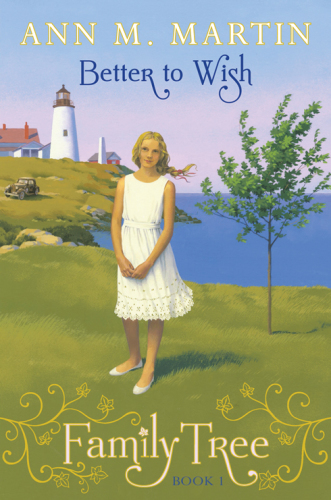
Better to Wish
Family Tree Series, Book 1
فرمت کتاب
ebook
تاریخ انتشار
2013
Lexile Score
790
Reading Level
3-4
ATOS
4.7
Interest Level
4-8(MG)
نویسنده
Ann M. Martinناشر
Scholastic Inc.شابک
9780545539265
کتاب های مرتبط
- اطلاعات
- نقد و بررسی
- دیدگاه کاربران
نقد و بررسی

dancer1234 - best book ever! So sad though:(

Starred review from April 1, 2013
Martin (Ten Rules for Living with My Sister) paints an authentic picture of white middle-class life during the 1930s in this first installment of the Family Tree series, tracing four generations of American girls. Growing up in Maine, eight-year-old Abby Nichols is the oldest daughter of an ambitious carpenter eager to realize the American Dream. But his prejudices are strong, too: he won’t let Abby associate with her Irish Catholic neighbor, Orrin, among others. As Abby’s father gains success, she enjoys more privileges, including a big new house in the city, but the family’s newfound prosperity doesn’t ease her outrage over her father’s mistreatment of the less fortunate, including Abby’s mentally impaired baby brother. Besides addressing the subject of bigotry, Martin underscores the powerlessness of wives and children at the time, revealing the positive and negative sides of tight family bonds. Abby grows into a resilient young woman (the novel spans more than 10 years), willing to speaks her mind and
assert her independence. Martin incorporates universal themes into this period piece, and her poignant writing is sure to satisfy fans. Ages 8–12. Agent: Amy Berkower, Writers House.

April 15, 2013
Martin delivers the first novel of a planned quartet, set to span four generations of daughters. In a brief prologue, 100-year-old Abby muses about time's swift passage and the kaleidoscopic aspect of memories--and secrets-- recalled from the past. Readers meet Abby Nichols at age 8 in 1930. She's big sister to Rose, good friend to Sarah and Orrin, and she's already expert at navigating the moods of her domineering father, Luther, and emotionally fragile mother, Nell. Ensuing chapters cover 15 years. Luther builds a prosperous business, moving the family from their small Maine seaside cottage to a fancy house in a larger town. Servants, store-bought dresses and Zander, the appealing boy next door don't dampen Abby's longing for the authentic friendships of life before. Her academic and social successes are pummeled by tragedy: Beloved Sarah drowns in an icy pond, and Nell breaks after Luther secretly institutionalizes their developmentally disabled 5-year-old son. While outwardly obeisant to her bigoted father--who cruelly forbids friendships, jobs and college--Abby builds a capacity for compassion that sustains her siblings. Eventually--and critically--she learns to use it to nurture herself. In a 1945 epilogue, Abby's a working girl in New York City--and Zander's on her doorstep. Some threads--whither Orrin?--are left dangling. But the deftly rendered theme of personal resilience, laced with romance and Americana, will earn this a deservedly wide audience. (Historical fiction. 8-12)
COPYRIGHT(2013) Kirkus Reviews, ALL RIGHTS RESERVED.

June 1, 2013
Gr 3-7-In a small town in 1930s Maine, Abby Nichols is happy in her small bungalow by the sea. Life is stable, but not without challenges; her father has a volatile temper and is biased against people who are different and her mother experiences bouts with sadness and sees ghosts from the past. However, Abby finds solace and pleasure in her longtime friendships with Orrin and Sarah. Despite the changing times and the onset of the Great Depression, the family furniture business begins to boom and her father proudly moves them to a big house in a bigger town, complete with hired help. Regretfully saying goodbye to the house and friends she's so fond of is only the beginning of a life of love and loss, triumph and struggle for Abby. This first in a series is sure to be a hit with children, especially fans of historical fiction. The descriptive writing transports them right back to this fascinating period in time when families grappled with economic challenges, civil-rights injustices, and everyday concerns. Martin writes with respect for her readers, piquing their interest in history and tackling real-life issues head-on, but with grace. The series will continue with three more books following the lives of Abby's daughter, granddaughter, and great-granddaughter.-Amy Shepherd, St. Anne's Episcopal School, Middleton, DE
Copyright 2013 School Library Journal, LLC Used with permission.

June 1, 2013
Grades 5-7 Abby's story begins in 1930, when she is eight years old and a traveling fair visits her village in Maine. While coping with her strict father's intolerance and her gentle mother's depression, she grows up chapter by episodic chapter, buying her sister a tea set for Christmas, losing her closest childhood friend, and feeling angry but helpless when her father institutionalizes her five-year-old brother, who has developmental disabilities. Eventually, Abby turns down the suitor her father insists that she marry and moves to New York City alone. With period attitudes woven seamlessly into the narrative, this historical novel reflects social norms during Abby's life. The individual scenes are vividly written and the overall story is engaging, but the 23-year time frame may limit its audience. However, in the Family Tree series, Martin plans to tell the stories of four girls from succeeding generations. Readers won over by Abby will happily look for her return as a mother, grandmother, and great-grandmother.(Reprinted with permission of Booklist, copyright 2013, American Library Association.)

























دیدگاه کاربران